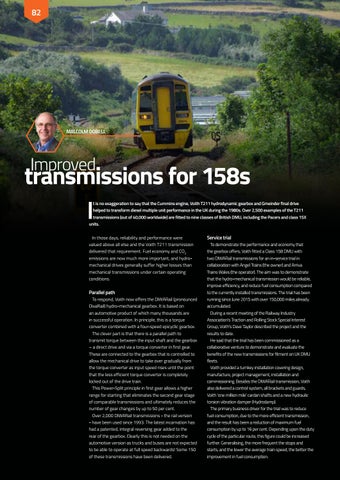82
Rail Engineer • August 2016
MALCOLM DOBELL
Improved
transmissions for 158s I
t is no exaggeration to say that the Cummins engine, Voith T211 hydrodynamic gearbox and Gmeinder final drive helped to transform diesel multiple unit performance in the UK during the 1980s. Over 2,500 examples of the T211 transmissions (out of 40,000 worldwide) are fitted to nine classes of British DMU, including the Pacers and class 15X units.
In those days, reliability and performance were valued above all else and the Voith T211 transmission delivered that requirement. Fuel economy and CO2 emissions are now much more important, and hydromechanical drives generally suffer higher losses than mechanical transmissions under certain operating conditions.
Parallel path To respond, Voith now offers the DIWARail (pronounced DivaRail) hydro-mechanical gearbox. It is based on an automotive product of which many thousands are in successful operation. In principle, this is a torque converter combined with a four-speed epicyclic gearbox. The clever part is that there is a parallel path to transmit torque between the input shaft and the gearbox – a direct drive and via a torque converter in first gear. These are connected to the gearbox that is controlled to allow the mechanical drive to take over gradually from the torque converter as input speed rises until the point that the less efficient torque converter is completely locked out of the drive train. This Power-Split principle in first gear allows a higher range for starting that eliminates the second gear stage of comparable transmissions and ultimately reduces the number of gear changes by up to 50 per cent. Over 2,000 DIWARail transmissions - the rail version - have been used since 1993. The latest incarnation has had a patented, integral reversing gear added to the rear of the gearbox. Clearly this is not needed on the automotive version as trucks and buses are not expected to be able to operate at full speed backwards! Some 150 of these transmissions have been delivered.
Service trial To demonstrate the performance and economy that the gearbox offers, Voith fitted a Class 158 DMU with two DIWARail transmissions for an in-service trial in collaboration with Angel Trains (the owner) and Arriva Trains Wales (the operator). The aim was to demonstrate that the hydro-mechanical transmission would be reliable, improve efficiency, and reduce fuel consumption compared to the currently installed transmissions. The trial has been running since June 2015 with over 150,000 miles already accumulated. During a recent meeting of the Railway Industry Association’s Traction and Rolling Stock Special Interest Group, Voith’s Dave Taylor described the project and the results to date. He said that the trial has been commissioned as a collaborative venture to demonstrate and evaluate the benefits of the new transmissions for fitment on UK DMU fleets. Voith provided a turnkey installation covering design, manufacture, project management, installation and commissioning. Besides the DIWARail transmission, Voith also delivered a control system, all brackets and guards, Voith ‘one million mile’ cardan shafts and a new hydraulic torsion vibration damper (Hydrodamp). The primary business driver for the trial was to reduce fuel consumption, due to the more efficient transmission, and the result has been a reduction of maximum fuel consumption by up to 16 per cent. Depending upon the duty cycle of the particular route, this figure could be increased further. Generalising, the more frequent the stops and starts, and the lower the average train speed, the better the improvement in fuel consumption.
